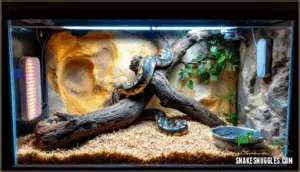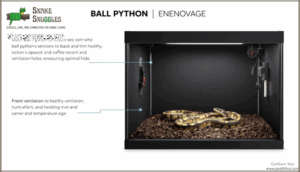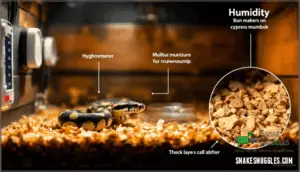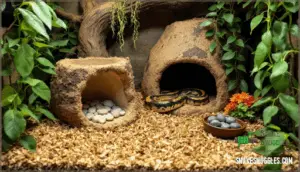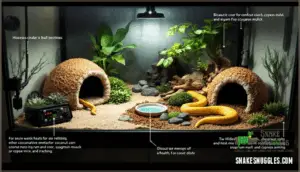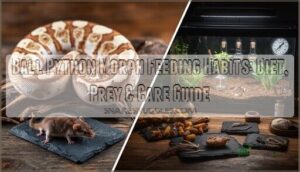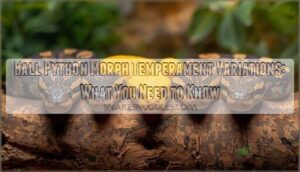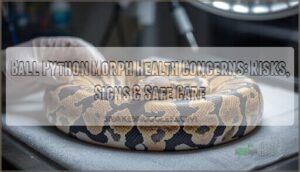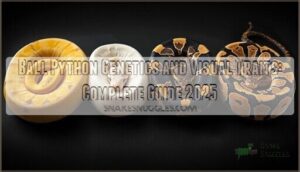This site is supported by our readers. We may earn a commission, at no cost to you, if you purchase through links.

The right enclosure feels secure on every side, with warmth falling in gentle gradients and humidity lingering at just the right level. Substrate, décor, and lighting don’t just fill space—they bring out your snake’s instincts, calm their nerves, and spark curiosity.
Dialing in your ball python cage setup tips can transform an ordinary tank into a haven you’ll both appreciate.
Table Of Contents
Key Takeaways
- Choose a secure, escape-proof enclosure with opaque sides and proper ventilation, using materials like PVC for insulation and durability.
- Maintain temperature gradients with digital thermometers and thermostats, ensuring basking areas reach 88–92°F and humidity stays between 50–60%, increasing during shedding.
- Provide at least 4 inches of moisture-retaining substrate like coconut husk or cypress mulch to support burrowing and stable humidity.
- Offer multiple hides, safe décor, and climbing features to encourage natural behaviors, reduce stress, and promote overall well-being.
Choosing The Right Ball Python Enclosure
Picking the right enclosure is the first big step for your ball python’s well-being. There are several styles, materials, and features to think about before you set up their new home. Here’s what you need to know as you explore your options.
Recommended Enclosure Size and Dimensions
Getting the right enclosure size is the foundation for your ball python’s comfort and confidence. Always match enclosure dimensions to the full length of your snake—think at least 48" long, 24" wide, and 24" tall.
Vertical space matters for climbing, while ample enclosure depth accommodates natural burrowing. Secure corners and proper escape proofing turn an ordinary ball python enclosure into a safe haven.
Best Materials for Enclosures
If you’re weighing materials, PVC offers superior durability and thermal efficiency, while glass impresses with its clarity but loses heat quickly due to high conductivity. Acrylic enclosures strike a balance—lighter and resistant to warping, yet prone to scratches. Wood remains budget-friendly, but ongoing maintenance is a must.
PVC enclosures are also a great choice because they offer excellent insulation properties. Consider your snake’s needs and your own cost comparison before picking what fits your setup best.
Importance of Opaque Sides and Ventilation
When you’re picking materials for your enclosure, it’s just as important to make sure the sides are opaque and the ventilation is spot on if you want your ball python to feel secure and breathe easy. Opaque sides provide:
- Stress Reduction
- Security Benefits
- Airflow Balance
- Respiratory Health
Smart enclosure design means weaving peace of mind into every detail.
Front-opening Vs. Top-opening Designs
Once your snake feels safe behind those opaque sides, the way you access the cage—front or top—can make daily care and interaction a whole lot easier.
Front-opening ball python enclosures score high for accessibility, cleaning ease, and spatial efficiency. Top-openers might seem classic, but front-openers also boost snake security and design aesthetics, making them the smart choice when setting up a ball python enclosure.
Optimizing Lighting and Heating
Lighting and heat matter as much as the walls around your ball python. Getting these core elements right is key to a healthy, active snake. Here’s how to make sure your setup meets every need.
Proper Heat Lamp and UVB Lamp Placement
Getting your heat lamp and UVB lamp in just the right spot is the secret sauce for keeping your ball python thriving. Position heat lamps and UVB at the ideal distance for safe exposure—check lamp wattage and use combined fixtures for efficiency. Aim light at a gentle basking angle, always preventing overheating by monitoring temperature directly at the basking distance.
Temperature Gradients and Basking Spots
Along the length of your enclosure, a temperature gradient is non-negotiable—your ball python depends on it. Place your heat lamps to create a basking surface that reaches 88–92°F, making certain the cool side stays 78–80°F. Don’t trust old dial thermometers; use digital probes for accurate readings and monitor nocturnal drops. This careful balance heads off heat stress. Humidity levels should be maintained with daily misting techniques.
- Establish a temperature gradient
- Use heat lamps to create basking spots
- Monitor cool and warm zones with digital probes
- Make certain basking surface temperature is 88–92°F
- Allow for nocturnal drops without dipping below 75°F
Safe Use of Thermostats and Heat Mats
Before you plug in that heat mat or set your thermostat, let’s make sure your safety checks are in place for both you and your snake. Thermostat calibration comes first—confirm accuracy with temperature probes.
Position the mat beneath the enclosure, away from water, and always use a timer integration. This routine helps you prevent malfunctions and guarantees reliable temperature regulation for snakes day and night.
Preventing Burns and Heat Stress
Nothing ruins a ball python’s day—or yours—like an accidental burn, so let’s talk about keeping those hotspots in the safe zone. Place heat lamps and mats with care, using thermostat calibration and a digital thermometer to monitor temperatures.
A steady gradient—with safe basking spots and a proper nighttime drop—protects against heat stress. Always double-check ambient temperature for peace of mind.
Maintaining Ideal Humidity Levels
Keeping your ball python comfortable starts with getting the humidity just right. It’s easier than you might think, as long as you know what to watch for.
Here are the key ways to make sure your enclosure stays in the ideal range.
Target Humidity Percentages for Ball Pythons
Ever wondered why wild humidity is so important for your ball python’s health? Aim for these main targets when maintaining humidity levels:
- 50–60% humidity for daily life.
- Boost to 65–75% as shedding humidity when skin changes start.
- Avoid low humidity (risking incomplete sheds) and high humidity (risking respiratory issues).
Proper humidity monitoring keeps your pet thriving.
Tools for Monitoring and Controlling Humidity
Keeping an eye on humidity isn’t guesswork—think of a digital hygrometer as your personal weather station, making cage care precise and stress-free. For best results, pair hygrometer accuracy with a digital thermometer and humidity controller.
Automated misting systems and the right humidifier types help maintain humidity levels, while monitoring substrate moisture aids every adjustment for your ball python’s well-being.
Creating and Using Humid Hides
Once you’ve got your humidity under control, it’s time to give your ball python a cozy humid hide—think of it as their private spa for stress-free living and healthy sheds. Choose the right moss type, location, and size for best results:
- Fill with moisture-retaining substrate.
- Place in a warm zone.
- Clean regularly for ideal humidity and health.
Adjusting Humidity During Shedding
When your ball python starts to shed, bumping up the humidity is like giving them a little extra help through their big wardrobe change. Shedding frequency varies, but aim for a controlled humidity spike—around 70–75%—using gentle misting techniques or a humidifier.
Hydration is critical. A moisture-retaining substrate and daily checks prevent stuck shed, promoting smoother sheds and a comfortable environment every time.
Selecting Substrate and Cage Décor
A well-chosen substrate and the right cage décor do more than look nice—they help your ball python feel safe and thrive. When you’re picking what goes inside the enclosure, it pays to think about both comfort and natural actions.
Here’s what to weigh when choosing each part.
Best Substrate Materials for Moisture Retention
Substrate selection can make or break your snake’s comfort. Coconut husk and cypress mulch set the standard for moisture-retaining substrate, offering consistent humidity and mold resistance. Sphagnum moss is perfect for humid hides, while topsoil mixes add natural bioactive balance.
For best results, consider weaving sphagnum moss or peat into bioactive substrates to maintain humidity and healthy microhabitats.
Calculating and Adjusting Substrate Depth
Figuring out how deep your substrate needs to be is just as important as picking the right material, especially if you want humidity to stay steady and your python to feel secure.
Aim for at least 4 inches of a moisture-retaining substrate, like coconut husk or cypress mulch. This depth encourages natural burrowing habits and creates a reliable humidity gradient for healthy shedding.
Choosing Safe Plants and Enrichment Items
Among the greenery and décor you add, picking the right plants and enrichment pieces can turn your snake’s enclosure into a true slice of the wild. Stick with safe plant species like pothos or snake plant—avoid anything toxic. Choose enrichment items without sharp edges and clean all décor regularly.
Safe plant options and thoughtful enrichment encourage natural actions and environmental enrichment effortlessly.
Providing Hides, Branches, and Climbing Features
Tucked beneath a sturdy hide or winding its way up a branch, your ball python will thrive with spaces that let it explore, climb, and feel secure. Secure hides and climbing enrichment mimic the wild by encouraging natural actions. Use:
- Hide boxes in warm and cool zones
- Thick, stable climbing branches
- Multiple hiding places
- Variety in animal hides for environmental enrichment
Ensuring Health and Comfort in The Enclosure
Your ball python’s well-being starts with a thoughtful enclosure setup. A few key details can make all the difference in their comfort and daily health.
Here’s what you’ll want to have in place.
Setting Up a Quarantine Enclosure
Think of a quarantine enclosure as your snake’s private retreat—a safe haven where you can monitor its health before moving to its permanent home.
Choose a simple setup: quarantine substrate for easy cleaning, secure hides for stress reduction, and minimal décor.
Stick to sterile conditions and strict cleaning protocols with veterinary-grade disinfectants.
Duration matters—keep your ball python quarantined for three to six months.
Placement and Cleaning of Water Dishes
A clean water dish isn’t just a luxury—it’s the heart of your python’s daily routine, keeping hydration and hygiene in perfect balance. Frequent cleaning guarantees water quality—essential for excellent ball python care.
A clean water dish is the foundation of your ball python’s daily health, safeguarding both hydration and hygiene
Place the dish on the cool side of the enclosure to help maintain humidity levels and prevent spills. Use sturdy, easy-to-clean materials and refresh water daily.
Reducing Stress With Multiple Hides
Ever notice how your snake seems to breathe easier when it’s got a favorite hideaway on both ends of the cage? Multiple hide boxes offer security and control, cutting down on stress and reducing aggression. Here’s what really matters:
- Hide Placement
- Size Matters
- Hide Materials
- Secure Feeling
- Visual Obstruction
Your ball python thrives when choosing hiding spots feels natural.
Promoting Exercise and Natural Behaviors
Your ball python won’t get lazy if its enclosure offers climbing structures, burrowing-friendly substrate, and décor that sparks natural curiosity. Enclosure size matters—larger spaces with magnetic ledges, climbing branches, and plants boost movement by 44%.
Add visual obstruction through varied décor, offer bathing benefits with a spacious water dish, and support foraging habits with scent-based feeding. Watch burrowing needs flourish when substrate depth hits four inches.
Frequently Asked Questions (FAQs)
How often should you completely clean the enclosure?
You’ll want to schedule a deep cleaning of your enclosure every four to six weeks. This Cleaning Frequency keeps Waste Buildup under control.
Remember, regular Substrate Replacement and veterinary-grade Disinfecting Agents are essential preventative measures for health.
What should you do if mold appears in the cage?
When mold shows up—like an uninvited guest—identify mold quickly, remove mold and contaminated substrate, and safely disinfect surfaces. Adjust humidity levels and enclosure ventilation.
Swap sphagnum moss and boost airflow to prevent recurrence. Ventilation importance can’t be overstated.
How can you safely introduce new décor items?
Before adding substrate and décor, quarantine décor items for a week and use veterinary-grade disinfectants as part of your cleaning protocols.
Gradual introduction and consistent observation of actions confirm material safety and prevent stress during enclosure decoration changes.
Can live plants cause issues in the enclosure?
Live plants bring benefits, but they’re not always risk-free. Plant toxicity, root rot, pest introduction, soil contamination, and even structural damage from roots can impact the substrate, humidity, and overall environment in your enclosure décor.
What signs indicate your ball python is stressed?
Watch for feeding refusal, hiding excessively, or defensive striking. Unpredictable actions, scale discoloration, and constant attempts to escape the enclosure often point to stress.
Address humidity and temperature to safeguard ball python health and promote proper care.
Conclusion
A well-crafted enclosure doesn’t just meet your python’s needs—it elevates their world to one of near-mythical comfort. When you apply these ball python cage setup tips, you don’t just prevent stress; you encourage natural actions, color, and confidence you won’t believe until you see it firsthand.
Every temperature check, every new hide, is a thread in the tapestry of your snake’s wellbeing. Your attention to detail isn’t just care—it’s the magic that transforms a simple tank into a sanctuary.
- https://reptifiles.com/ball-python-care-guide/ball-python-terrarium-size-lighting/
- https://www.zenhabitats.com/blogs/reptile-care-sheets-resources/ball-python-complete-lighting-and-heating-guide
- https://www.youtube.com/watch?v=Dofb-Z-bMoQ
- https://reptilesupply.com/blogs/how-to-guides/how-to-set-up-a-ball-python-enclosure
- https://www.reddit.com/r/ballpython/comments/r3kp02/best_substrate_for_ball_python/

